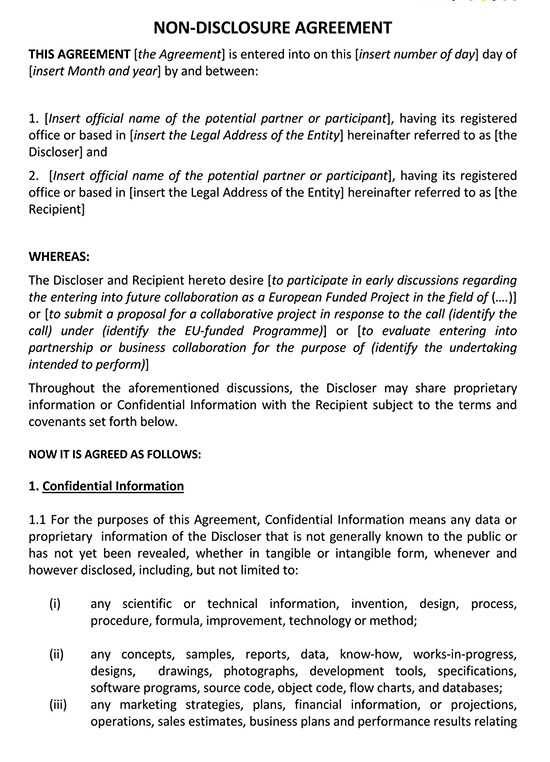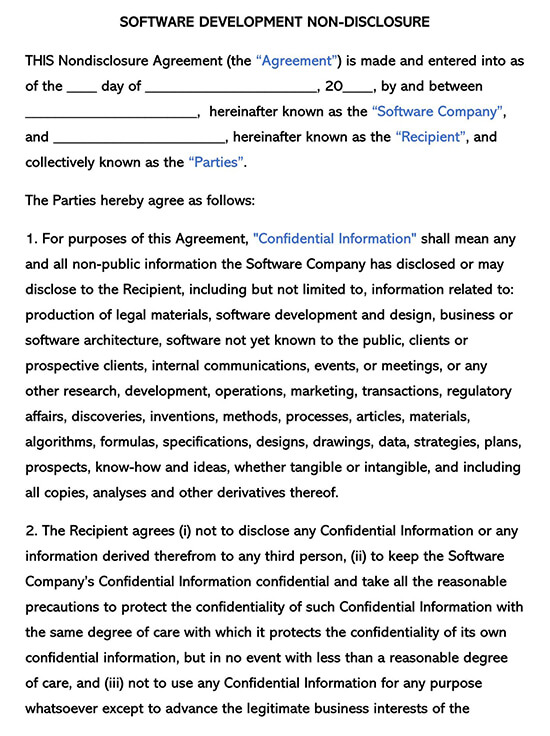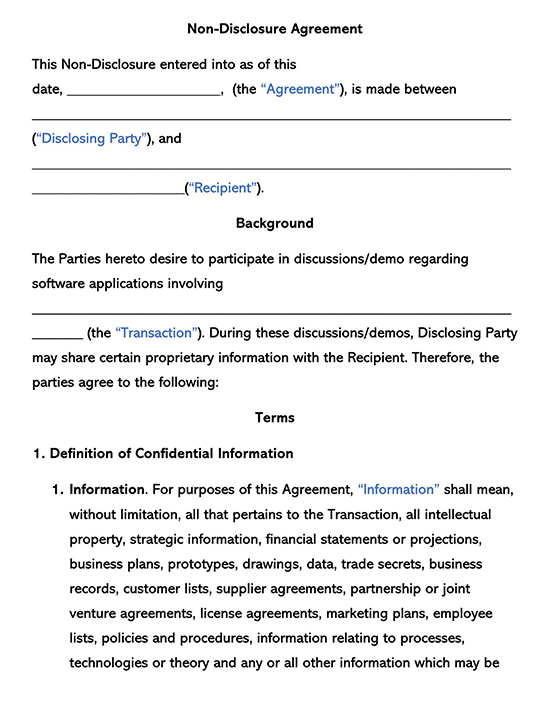The software development non-disclosure agreement (NDA) is intended for use when one wishes to share software business trade secrets with consultants, contractors, investors, potential licensees, and any other party that wants to access a company’s Confidential Information.
A non-disclosure agreement (NDA) is a legal agreement between two or more parties, for instance, the software developer (a software development firm) and yourself, defining the scope of the Confidential Information to be shared and requiring that the information shared be kept confidential.
Software development non-disclosure agreement is customarily used when parties are looking to enter into a business relationship. An NDA, in this case, helps the parties to discuss at large without fear of Confidential Information, for example, trade secrets, being exposed, or stolen. NDAs usually specify the type of project; for instance, the development of a new application should only be discussed with those who have signed the NDA.
If you are thinking of creating or even licensing Software, you will definitely come across something known as software source codes. These source codes are categorized into two:
- Proprietary
- Open-source
For instance, when you install Microsoft’s Software, the source code is proprietary. Microsoft will do this to protect its intellectual property and to further prevent any user from making unwarranted changes to the source code.
Open-source codes, for example, those under the GNU General Public License, is available for any person to modify, use, and/or share with others. The sole purpose of open-source codes is basically to encourage programmers to work together and help make it more useful and powerful for other users.
This Agreement defines:
- Parties to the Agreement
- What exactly is to be considered confidential
- The scope of confidentiality
- Exclusions from confidentiality
- Obligations of the parties
- Consequences of breaching the contract
You can decide to either use non-disclosure agreement, trade secret laws, copyright laws, or patents to protect Proprietary source code.
Free Templates




Benefits of Signing a Software Development NDA
- An NDA gives you the confidence to share any confidential Information knowing that the other party is obliged to maintain its confidentiality.
- Consequently, an NDA will provide you with a glimpse of what you can expect from the other Party’s legal department during the cooperation in the future in terms of flexibility, speed, and overall engagement.
- In addition to that, a software development non-disclosure agreement will secure any trade secrets or documents disclosed during the entire duration of the relationship, as stipulated in the Agreement.
- Lastly, an NDA will define the time frame of the corporation during the future of the business. Both parties acknowledge in signing the Agreement that they will uphold the confidentiality of the information and agree not to disclose it without the consent of the disclosing Party.
Negotiating Software Development Agreements
Before signing an NDA, you must first read through it to make sure it is fair to you. Consequently, you must make sure that you have enough understanding of what you are signing.
Below are some of the things you must consider before acknowledging an agreement:
Timing
Who, why, and when are you being asked to sign the document. Usually, it is unreasonable for a potential client to ask you to sign an NDA before giving you some necessary information about the project. They typically give out a general overview of the project so that when you finally agree to work with them, you have an understanding of what you are getting yourself into.
Do not sign an agreement before actually having an idea of what the project is. You may find yourself having a conflict of interest or worse: not have the expertise required for the project.
What does the NDA say about the source of the Confidential Information?
As a developer, you will want the NDA to be flexible enough to permit you to use information obtained from the public domain in any other projects you do for other parties without any limitations. Some NDAs would prohibit you from using such information, regardless of the source, as long as it has been used on their projects.
Confidential information vs. trade secrets
Does the NDA clearly define what is to be considered a Trade Secret, and what is to be termed as Confidential Information? A well written NDA will definitively make clear the difference.
Effective length of confidentiality
There must be a set duration to which the Confidential Information must remain as such. Most software non-disclosure agreements are usually short-termed due to rapid technological advancements. Thus, you wouldn’t want to be tied to a customarily long term agreement.
Consequences of breach
The NDA must stipulate clearly, the consequences of breaching the Agreement. Both parties in the Agreement must clearly understand what is being asked of them and the consequences that may result in failure to abide by the rules stipulated in the Agreement. These consequences include legal liability, loss of professional reputation, monetary damage, and injunctions from the court.
How to Write a Software Development Non-Disclosure Agreement
- Introductory Paragraph: The “Disclosing Party” is the owner of the Confidential Information, and the “Receiving Party” is the person/company receiving the Confidential Information and is tasked with keeping the confidentiality of the information. Include the effective date of the Agreement. If either Party is a business, always include the proper name of the company.
- Definition of Confidential Information: All non-disclosure agreements have a clear definition of what is to be termed as Confidential Information. This gives gist to the Agreement and establishes the critical issue of the disclosure.
- Exclusion from Confidential Information: This clause defines all the types of information that are not in any way covered by the Agreement and are not meant to be treated as confidential. These exclusions are usually based on state trade laws or court decisions,
- Obligations of the Receiving Party: In this paragraph, you should make clear what is expected of the Receiving Party upon acknowledging the Agreement. The receiving party must understand that they are not allowed to reveal any confidential information without the Disclosing Party’s consent.
- Periods: Every NDA must have a specified period for the Agreement. In this clause, include the duration the Agreement is supposed to last. For IT projects, the time duration may be short compared to other projects due to the rapid change in technology.
- Relationships: You must clearly define the nature of the relationship in this clause. This is to help disclaim any relationships not set in the Agreement.
- Severability: If any part of the provision is deemed invalid or enforceable by the court. The provision shall be set aside, and the rest of the provision shall be interpreted to influence the intent of the parties.
- Integration: This clause cannot be amended in any way as it expresses the total understanding of the Agreement, and it supersedes any prior proposals, agreements, representations, and perceptions.
- Waiver: This clause should make it clear that the failure to implement any rights provided in this Agreement shall not waive of any prior or subsequent rights.
- Injunctive Relief: This clause describes that one of the parties may seek to stop the other party in the Agreement from doing something that is against the Agreement. Injunctive relief is to be in addition to all the other remedies that are available to the Disclosing Party.
- Indemnity: The recipient of the information agrees to indemnify the Disclosing Party against any losses, damages claims, expenses incurred due to the breach of this Agreement.
- Attorney Fees and Expenses: This clause should categorically define what is to happen to the Attorney Fees and Expenses that may arise from any disputes in the Agreement. It should make clear that the prevailing party in the difference shall be bestowed the right to collect any attorney fees and any other expenses incurred from the conflict.
- Jurisdiction: This clause defines the state in which the applicable laws set in the Agreement are from. Consequently, allowing each party to consent in advance to the established jurisdiction, thereby giving up the right to be sue or be sued anywhere else.
- Governing Law: This paragraph includes the law that will govern the Agreement. In most cases, the Disclosing Party (individual) will choose the laws where the Company headquarters of the Receiving Party are located.
- Successors and Assigns: This clause governs any company that acquires either party.
- Signatures: Each party must sign or designate someone with the authority to sign the documents. It is recommended that each party sign at least two copies and keep one to ensure that they both have the original signed Agreement.
Software Development Non-Disclosure Agreement Template
I. THE PARTIES.
This Software Development Non-Disclosure Agreement, also referred to as the “Agreement,” created on the _ day of___________,20_ is by and between ___, in this agreement referred to as the “Disclosing Party” and ___, referred to as the “Receiving Party,” and collectively known as the “Parties.”
WHEREAS, this Agreement is purposely created to prevent the unlawful disclosure of confidential and proprietary information with regards to the development of ______ [name of software] with the purpose of _________ [Describe the Purpose of the software], referred to as the “Software.”
The Parties agree as follows:
II. TYPE OF AGREEMENT. Choose one (1)
Mutual— this mutual Agreement shall, whereas, both Parties shall be prohibited from disclosing confidential and/or proprietary information that they will share with one another to develop the Software.
Unilateral— this Agreement shall be unilateral, whereas, the Disclosing Party shall have sole ownership of the Software with the Receiving Party being prohibited from disclosing the Confidential and Proprietary Information that is to be released by the Disclosing Party to develop the Software.
III. DEFINITION OF CONFIDENTIAL INFORMATION.
“Confidential Information” shall include all information and/or material that has economic value or other utility in the business in which Party A or Party B is engaged. If either Party discloses the “Confidential Information” in writing, that Party shall, in writing, outline or stamp the provisions with the word “Confidential” or use any similar warnings. Whereas, if the “confidential Information” is transmitted orally, the Party disclosing the information shall also, in writing, state that such oral communications constituted Confidential Information.
IV. EXCLUSION FROM CONFIDENTIAL INFORMATION
Both Parties obligations with regards to this Agreement do not extend to information that is: (a) at time of disclosure, already available to the public or through no fault of either Party becomes publically known; (b) previously known by the other Party before signing this Agreement; (c); learned by either Party (Receiving Party) through other legitimate means other than the disclosing Party; (d) is disclosed to either Party before any written approval.
V. OBLIGATIONS OF RECEIVING PARTY
The Receiving Party upon signing this Agreement shall be bound to uphold at all times the confidentiality of the information for the sole exclusive benefit of the Disclosing Party and shall only share the Confidential Information obtained through this Agreement only upon approval by the Disclosing Party and shall not for their own benefit publish, replicate, or permit the use of this Confidential Information by others for their personal interest or to the detriment of the Disclosing Party. Any Confidential Information obtained through this Agreement shall, upon request in writing by the Disclosing Party, be returned to them immediately.
VI. PERIODS
The Receiving Party shall at all times uphold the integrity and confidentiality of the “Confidential Information” upon signing this Agreement. The “Confidential Information” shall remain confidential from, [date] until it ceases to be confidential or is released, in a written notice, from retaining its confidentiality by the Disclosing Party.
VII. RELATIONSHIPS
Whereas this Agreement institutes a new relationship between the parties, it shall not in any way be deemed to initiate either Party a partner, joint venture, or employee of either Party for any purpose thereof.
VIII. INTEGRATION
Both Parties acknowledge that (a) they completely understand all the terms and conditions set with regards to the Agreement. (b) This Agreement supersedes all prior proposals, agreements, representations, and understandings. (c) This Agreement shall not in any way be amended after it has been executed and shall only be modified upon written consent from both parties.
IX. WAIVER
Failure to implement any rights provided in this Agreement shall not in any way be a waiver of any prior or subsequent rights.
X. GOVERNING LAW
This Software Development Non-Disclosure Agreement shall be governed under the laws in State of _________________
XI. SIGNATURE
Both Parties in this Agreement agree through its authorized representatives to enter into this Agreement upon signing.
Signature (Disclosing Party)
Name
Date
Signature (Receiving Party)
Name
Date
Frequently Asked Questions
You cannot amend an expired NDA. Once expired, you will have to enter into a new agreement.
Each State/Region or Province have their own set of laws. The selection you make is used to customize the document to your specific jurisdiction.












